Ghost of Yōtei PS5 Pro Review – Ronin Around
Summary: AAA samurai action with style, depth and thrilling combat; an open-world triumph.
4.6
Ronin Around
The path of a wandering samurai is often paved with complex twists and unexpected turns, so it’s a surprise Ghost of Yōtei mostly plays its premise of underdog vengeance as straightforward as a single, clean sword cut.
Thankfully, where Ghost of Yōtei’s slice of revenge slightly lacks in deeper machinations, it more than makes up for in style, gameplay depth, and the sheer amount of new ways to play and things to do.
Set over 300 years after Ghost of Tsushima, the narrative centers on Atsu, who returns to her childhood home of Ezo to hunt down the Yōtei Six, a group of masked samurai (with names like the Oni, Kitsune, and Spider) led by Lord Saito who brutally murdered her family. The game wastes no time to pit you against her enemies and establish Atsu’s reputation as an onryō (ghost) within minutes in its opening sequence, before revealing the Yōtei Six are spread out across five different regions of lawless Ezo, naturally begging to be explored. Oh, and you can choose which order to pursue and kill them. Cool!
However, while the premise and immediate freedom on offer is intriguing, I found the plot to be fun but predictable, used mostly to propel the action forward. Ezo’s quick acceptance of the onryō, the fact she is a woman, and many of her extraordinary feats feels brushed over, while Atsu herself comes across as so singular in her purpose she remains uninteresting even when speaking about her past or herself to other, livelier characters she meets in her journey. But this may be a matter of taste; I like my revenge stories slow-and simmering. Here, it’s served hot and fast as an iaijutsu strike.
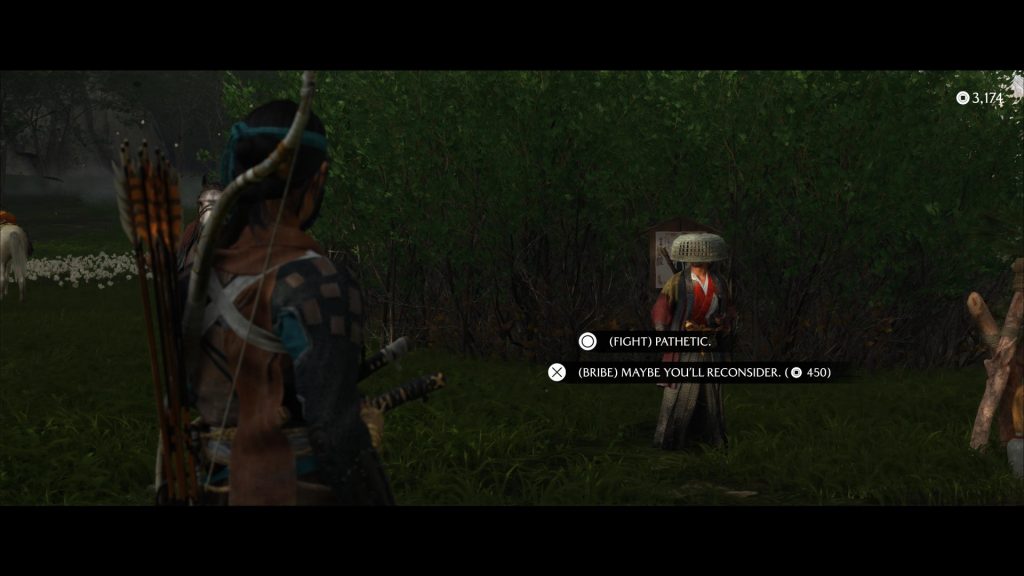
It’s the substantial side content that brings the exotic setting of Ezo, its many entertaining inhabitants, and Atsu’s revengeful heart to life. Like Tsushima, Yōtei spreads its story out through activities spread out across a sprawling open-world map. There are side-missions (divided by depth into Myths, Tales, and Jobs) where named and one-time characters come to Atsu for help their problems, solve local mysteries, or for vengeance of their own, which she is more than capable to oblige, wise senseis who teach the ways of new weapons like the kusarigama and odachi; cute fox dens and shrines to unlock charms and abilities; steaming onsens to rest; and the new simple but addictive Zeni Hajiki gambling mini-game. Where the stories sometimes fall short, the rewards and progression systems – unique armor and helms, ‘skins’ for Atsu’s swords, upgradable equipment, new abilities – prove addictive to chase.
Moving from place to place on horse and foot opens up dozens of smaller distractions, too, from picturesque landmarks (including Mount Yōtei itself) for Atsu to paint (and take screenshots of using the excellent in-game photo mode), to well-hidden loot caches and easter eggs, to chance meetings on the road with both friendly and hostile locals like the indigenous Ainu tribes, humble farmers and greedy ronin, who I quickly noticed serve to point you toward something more interesting on the map if you don’t find it first – very reminiscent of Red Dead Redemption 2’s random encounters system.
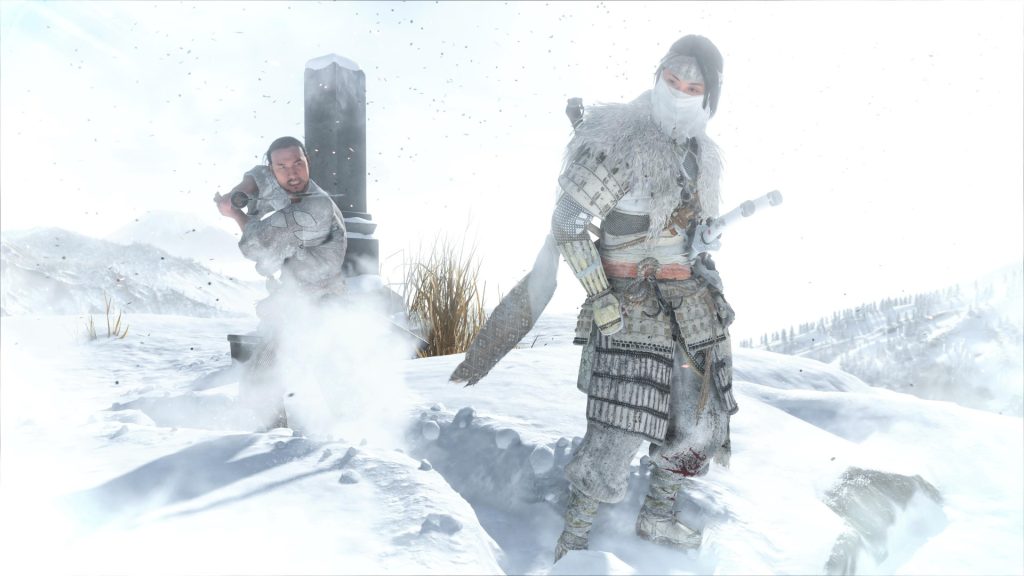
As Atsu, you can also stop to set up camp in the open-world. Campsites act as rest points so you can cook to obtain temporary combat bonuses, play Atsu’s shamisen to activate certain effects, and even talk to random passersby or buy goods from story NPCs who sell wares. The most unique quests are Yōtei’s numerous bounty hunter missions and wolf dens. Atsu can take on increasingly difficult contracts to dispatch outlaws, serial killers and conmen to help the locals and earn a quick coin; while brief, their stories add further depth to the wartorn Ezo and its traumatized populace. You can even find pricey bounties for Atsu, which grow as the story unfolds. It’s a neat way of marking progress!
Atsu can also help a local she-wolf extract her own revenge against poachers and murderous men picking off the local wolf population, and eventually bond, name and upgrade the wolf to summon her and aid her in battles against fortified strongholds held by Lord Saito’s men, where you can loot goods, free prisoners, and find scattered lore documents and campsites that flesh out the differences of the Yōtei Six, with my favourite being the Kitsune and his clan of shinobi (called the Ninetails) and the Spider, while Lord Saito himself is appropriately shrouded in ambiguity as the chief antagonist.

There is a lot to see, learn and do, and it feels like Sucker Punch seriously addressed criticisms about Tsushima’s static open-world by making Yōtei’s feel more lived in, with civilians, animals and enemies traveling frequently in more places. But the gamified nature of the wolf mechanic, as well as the camp and vendor systems, does break immersion in the setting from time-to-time.
Why? You’ll quizzically find this same lone wolf and same friendly vendors all across Ezo, seemingly teleporting to wherever your Astu happens to be active and exploring. It’s cool the game accommodates the order you explore the map, but why is this same annoying cartographer chasing me across the country, up snowy mountains and fortified checkpoints just to sell me wares?
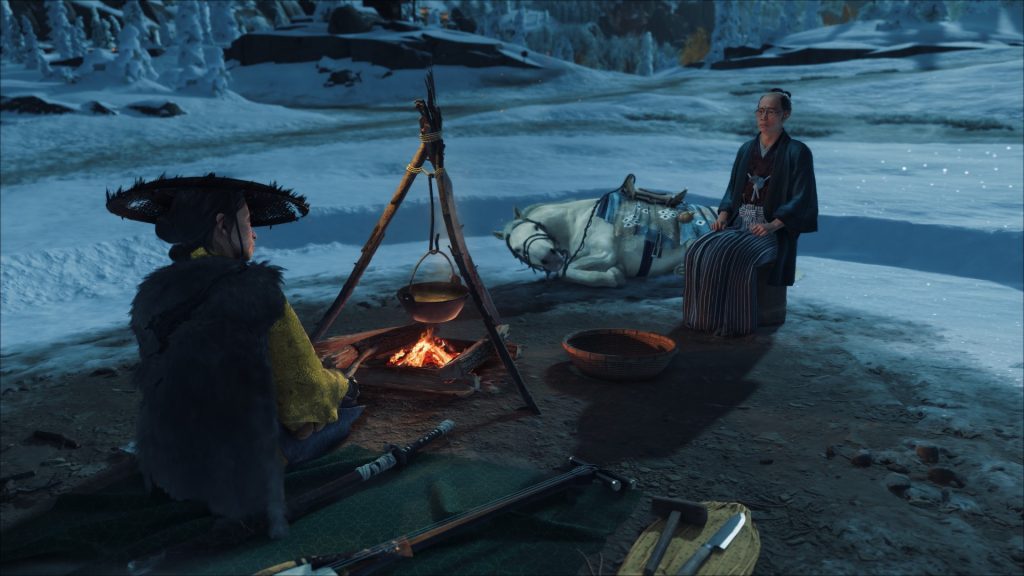
Sucker Punch absolutely nailed the non-linear quest, world design and wandering samurai fantasy, though. From the start, I made a beeline for the furthest region, snowy Teshio Ridge, just to see how the game would handle my out-of-order playstyle; to my delight, it handled it seamlessly. Main quests only referenced my choices so far, random encounters dynamically adjusted to my location, and like Tsushima, there’s subtle dialogue and quest changes based on what you’ve already done and how you approach things. Open-world fanatics and those who love gameplay reactivity will find a lot to love.
So, what about combat?
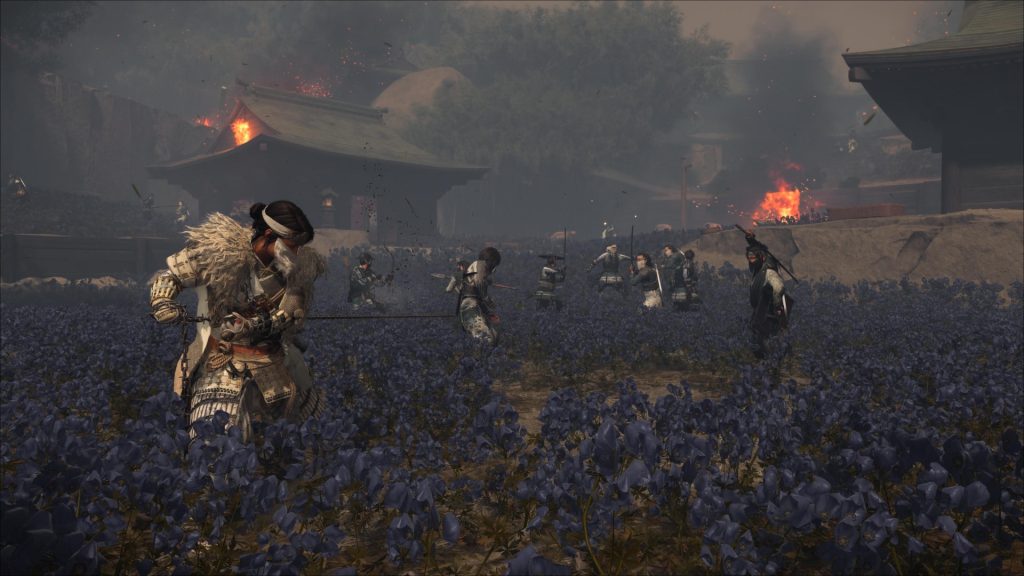
Patience is the parent of success, and where Ghost of Yōtei excels is its mastery of the small, visceral moments that make you feel like an expert swordsman. From the subtle shifts in the enemy’s stance to the weighty feel of cutting down an arrogant foe, the fantasy of wielding and killing with a katana was already well established in Tsushima, but greatly improved here. Each battle or duel feels like a highlight reel thanks to the many techniques you deploy and take hostiles down, from standard light and heavy attacks to unlockable combos, executions, and dirty tricks. The enemy AI is also fairly impressive – from charging brutes to sneaky shinobi to pesky bowmen, each deploy their own tactics to take you down, and you have to play smart in order to survive being outnumbered and outgunned.
The best and flashiest kills are achieved with the game’s parry system, but countering blows demands your careful attention. When successful, each win feels like a taste of well-deserved revenge as you out-smart opponents with precision. When direct combat is unfavourable or unpreferred, you can clear out the battlefield using stealth and assassination, which, while not revolutionary, is just as stylish and satisfying to accomplish thanks to varied environments and interactive items (tall grass, fallen weapons, etc) to use to your advantage. Other games focus on pure spectacle or RPG systems, but Yōtei earns its honours by offering a very strong and varied core combat loop.
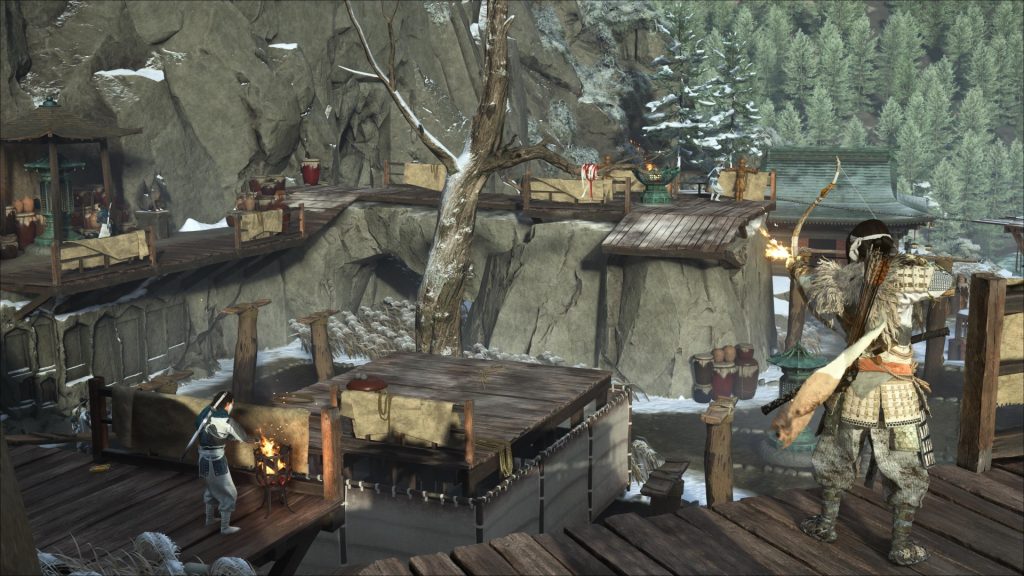
Now, you can play this game like a straightforward button masher (on the lowest difficulty setting) if you really want to, but the fun in Yōtei’s combat system is in mastering its underlying rock-paper-scissors structure and outsmarting opponents with the right tactics. Atsu’s weapons, which replace the stance system from Tsushima, offer distinct advantages and techniques to counter certain enemies and situations; dual katanas beat spear, spear beats katana, etc. My personal favorite weapon to use is the kusarigama, which breaks the shields of armoured soldiers before pulling them in like Scorpion from Mortal Kombat for the flashy kill.
Equipment such as the tanegashima (gun), kunai and smoke bombs can help control crowds or escape from the battlefield altogether, which came in handy with my preference for an agile shinobi playstyle. Of course, the katana is still the focus of the game, particularly in stand-offs, where you can challenge overly eager enemies to charge and die by your sword to thin the herd. Story-based duels are the most intense and fun to complete, acting as boss battles with a unique health-bar and gimmick to overcome (not to mention some bad-ass cinematic screenshots to snap).

What is readily apparent throughout the moment-to-moment gameplay is Ghost of Yōtei’s stunning presentation and visuals. The game offers four graphics modes that target either resolution (Quality), lighting quality (Ray-Tracing) or frame-rate (Performance), with the fourth mode (Ray-Tracing Pro) exclusive to PlayStation 5 Pro owners. Pro Mode mostly manages 60fps with modest image quality uplifted by the fantastically rendered landscapes and varied environments of feudal-era Ezo/Hokkaido; my favourite region was Teshio Ridge’s foggy mountain peaks and winter red trees falling on snow, and the lush green fields of the Grasslands swaying with the wind. This is a game where every corner of the map is fully curated for Photo Mode – or an appropriately dramatic samurai duel.
I quickly tempered my expectations when it came to character models and in-engine cutscenes, though. Yotei follows the same presentation style as Tsushima for open-world activities, where Atsu and other characters still speak as two static figures with the camera zoomed out. The sequel does offer more side-quests where you do interact with NPCs up-close, but it becomes clear many faces and voices are disappointingly re-used and lower quality than Atsu or the core cast. Yōtei does make improvements in general presentation, such as more emotive enemies and intricate animations during random encounters and combat stand-offs, but the hand-crafted character animations are saved for the main story, where the action moves from in-engine to pre-rendered cinematics. Like in Tsushima, I found the transition a bit jarring, as these story scenes play in 30fps regardless of your chosen graphics mode. Otherwise, the IQ on PS5 remains impressive – even if it isn’t quite the leap in raw graphical improvements that many may expect from a PlayStation Studios flagship title.
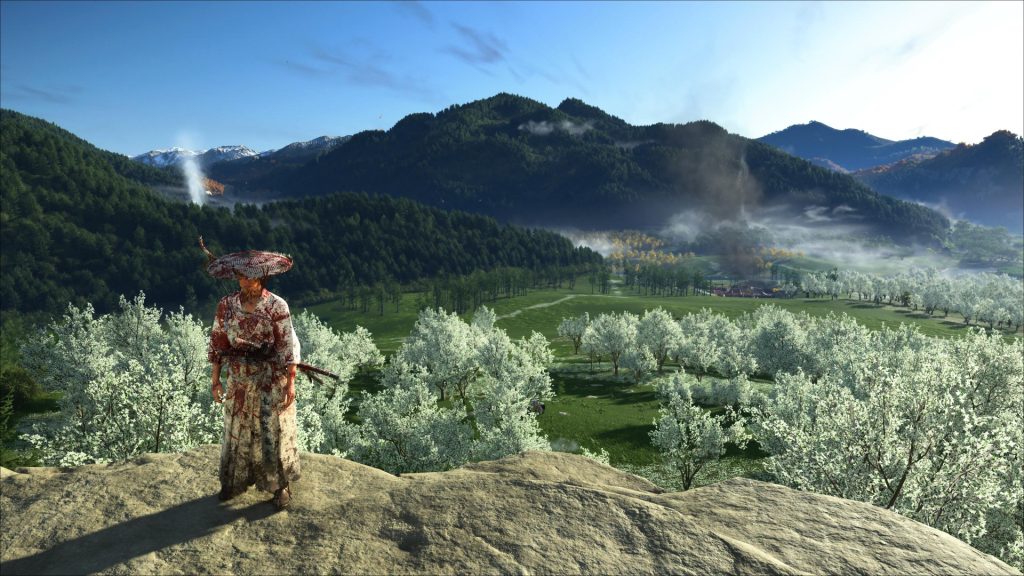
For all its other feats as a bigger and better sequel to Tsushima, my Yōtei playthrough was notably bug-free. The Ray-Tracing Pro mode sometimes displayed overly bright surfaces at certain times of the day, but otherwise Sucker Punch deserve major props in delivering an open-world title without the technical mess we unfortunately associate with modern triple-AAA releases.
Of course, there’s always a few blind spots with a game of this size. My minor gripes with Yōtei (its main story, too many nameless one-off NPCs, stilted English voice-acting delivery) mostly come down to subjective taste, but there are a few elements which may affect your enjoyment. Some questionable AI detection and spawning, a lack of English subtitles for background chatter when playing in Japanese (come on Sucker Punch, this also was a thing in Tsushima) and an under-tuned economy system are my biggest nitpicks, but nothing that outweighs the game’s sheer quality.
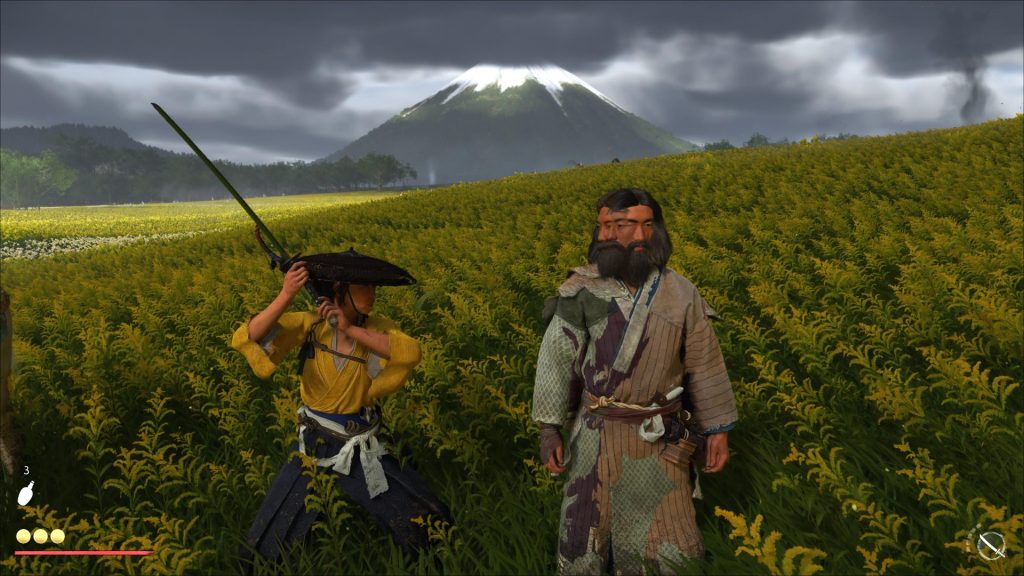
The Final Verdict
As someone who gets fatigued with modern open-world games easily, I enjoyed Ghost of Yōtei far more than I expected. It has all the hallmarks of a triple-AAA, first-party production from PlayStation Studios, but with far more spirit, style and effort than your average open-world title.
Developer Sucker Punch has produced a fantastic realization of Ezo/Hokkaido, a region of feudal Japan that we don’t get to see a lot of in games, let alone explore in such detail. Along with fun combat, quests, and progression systems, Yōtei will keep a lot of gamers busy, not even taking into account the free co-op multiplayer modes coming in 2026. A must-play for fans of open-world action-adventure games, and a worthy, albeit safe sequel to Ghost of Tsushima.
Game Details
Primary Format – Games – PlayStation 5
Game Genre – Action-adventure
Rating – MA 15+
Game Developer – Sucker Punch
Game Publisher – Sony Interactive Entertainment








